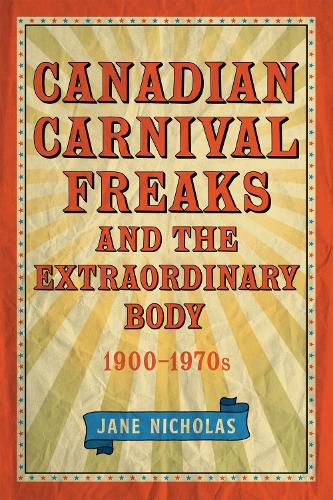Readings Newsletter
Become a Readings Member to make your shopping experience even easier.
Sign in or sign up for free!
You’re not far away from qualifying for FREE standard shipping within Australia
You’ve qualified for FREE standard shipping within Australia
The cart is loading…






In 1973, a five year old girl known as Pookie was exhibited as The Monkey Girl at the Canadian National Exhibition. Pookie was the last of a number of children exhibited as ‘freaks’ in twentieth-century Canada.
Jane Nicholas takes us on a search for answers about how and why the freak show persisted into the 1970s. In Canadian Carnival Freaks and the Extraordinary Body, 1900-1970s, Nicholas offers a sophisticated analysis of the place of the freak show in twentieth-century culture. Freak shows survived and thrived because of their flexible business model, government support, and by mobilizing cultural and medical ideas of the body and normalcy. This book is the first full length study of the freak show in Canada and is a significant contribution to our understanding of the history of Canadian popular culture, attitudes toward children, and the social construction of able-bodiness. Based on an impressive research foundation, the book will be of particular interest to anyone interested in the history of disability, the history of childhood, and the history of consumer culture.
$9.00 standard shipping within Australia
FREE standard shipping within Australia for orders over $100.00
Express & International shipping calculated at checkout
In 1973, a five year old girl known as Pookie was exhibited as The Monkey Girl at the Canadian National Exhibition. Pookie was the last of a number of children exhibited as ‘freaks’ in twentieth-century Canada.
Jane Nicholas takes us on a search for answers about how and why the freak show persisted into the 1970s. In Canadian Carnival Freaks and the Extraordinary Body, 1900-1970s, Nicholas offers a sophisticated analysis of the place of the freak show in twentieth-century culture. Freak shows survived and thrived because of their flexible business model, government support, and by mobilizing cultural and medical ideas of the body and normalcy. This book is the first full length study of the freak show in Canada and is a significant contribution to our understanding of the history of Canadian popular culture, attitudes toward children, and the social construction of able-bodiness. Based on an impressive research foundation, the book will be of particular interest to anyone interested in the history of disability, the history of childhood, and the history of consumer culture.